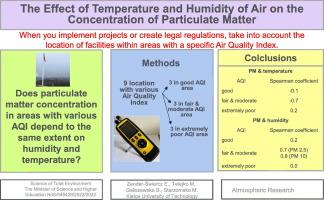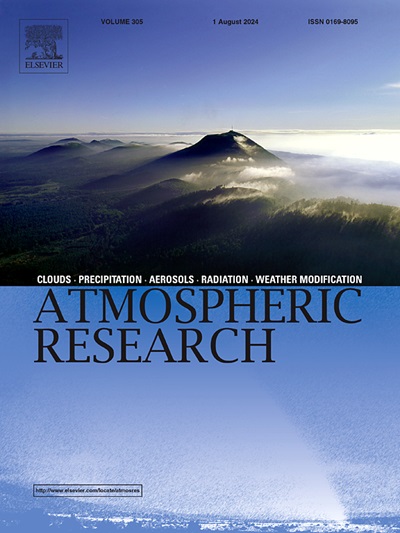空气温度和湿度对颗粒物--PM2.5 和 PM10 浓度的影响
IF 4.4
2区 地球科学
Q1 METEOROLOGY & ATMOSPHERIC SCIENCES
引用次数: 0
摘要
被视为空气质量标志的颗粒物也是人口(尤其是儿童)健康风险的指标,因为他们更容易受到所呼吸空气质量的影响。了解室外空气中颗粒物浓度与气象条件之间的相关性,有助于采取措施减少污染,降低威胁健康和生命的风险。多年来,世界各地的科学家一直在寻找气象条件对颗粒物浓度的影响之间的关系。尽管如此,人们仍然不知道这种关系是否在所有地方都相似。此外,科学家们对温度、湿度和颗粒物浓度之间相关性的方向和强度也没有达成一致。本文试图根据该地区的颗粒物空气质量指数(AQIPM)分类,将气象条件对颗粒物浓度的影响联系起来。研究对象包括三个具有特定空气质量指数的地点:极差、中等和amp;一般和好。研究在教育设施附近的九个地点进行。每个地点进行了四次测量。采用斯皮尔曼相关系数评估两者之间的关系,假定显著性水平为 0.05。研究假设如下在空气质量指数不同的地点,颗粒物与气象条件之间的相关性不同。研究结果清楚地表明,气象条件与颗粒物浓度之间的关系取决于空气质量指数的具体分类。相关性最强的是 "尚可 "和 "中等 "空气质量指数地区。与温度呈负相关,与湿度呈正相关。在空气质量指数极差的地区,没有观察到湿度与颗粒物浓度之间的关系。在空气质量良好地区,温度与颗粒物浓度的相关性很弱,湿度与颗粒物浓度的相关性很弱。本文章由计算机程序翻译,如有差异,请以英文原文为准。

The effect of temperature and humidity of air on the concentration of particulate matter - PM2.5 and PM10
Particulate matters accepted as air quality markers are also indicators of the health risk of the population, especially children, because of their increased susceptibility to the quality of the air they breathe. Understanding the correlations between the concentration of particulate matter in the outdoor air and meteorological conditions will help to take steps to reduce pollution and reduce the risk of threats to health and life. For many years, scientists from all over the world have been looking for relationship between the impact of meteorological conditions on the concentration of particulate matter. Despite this, it is still not known whether the relationships will be similar in all locations. Furthermore, there is no agreement among scientists on the direction and strength of the correlation between temperature, humidity, and particulate matter concentrations. The article presents an attempt to link the impact of meteorological conditions on particulate matter concentrations depending on the classification of the area into air quality index in the particulate matter (AQIPM) category. Three locations with a specific air quality index were included: extremely poor, moderate & fair and good. The research was carried out at nine locations near educational facilities. Four measurement series were carried out for each location. Spearman's correlation coefficient was used to assess the relationship with an assumed significance level of 0.05. A research hypothesis was adopted: The correlation between particulate matter and meteorological conditions is different in locations with different AQIPM. The results obtained clearly show that the relationships between meteorological conditions and the concentration of particulate matter depend on the classification of the area into a specific category of the air quality index. The strongest correlation occurs in the fair & moderate AQIPM area. In relation to temperature, there is a negative correlation, and in relation to humidity, positive. In the extremely poor AQIPM area, no relationship was observed between humidity and particulate matter concentration. In the good AQIPM area, the correlation in relation to temperature was very weak, in relation to humidity, weak.
求助全文
通过发布文献求助,成功后即可免费获取论文全文。
去求助
来源期刊

Atmospheric Research
地学-气象与大气科学
CiteScore
9.40
自引率
10.90%
发文量
460
审稿时长
47 days
期刊介绍:
The journal publishes scientific papers (research papers, review articles, letters and notes) dealing with the part of the atmosphere where meteorological events occur. Attention is given to all processes extending from the earth surface to the tropopause, but special emphasis continues to be devoted to the physics of clouds, mesoscale meteorology and air pollution, i.e. atmospheric aerosols; microphysical processes; cloud dynamics and thermodynamics; numerical simulation, climatology, climate change and weather modification.
 求助内容:
求助内容: 应助结果提醒方式:
应助结果提醒方式:


